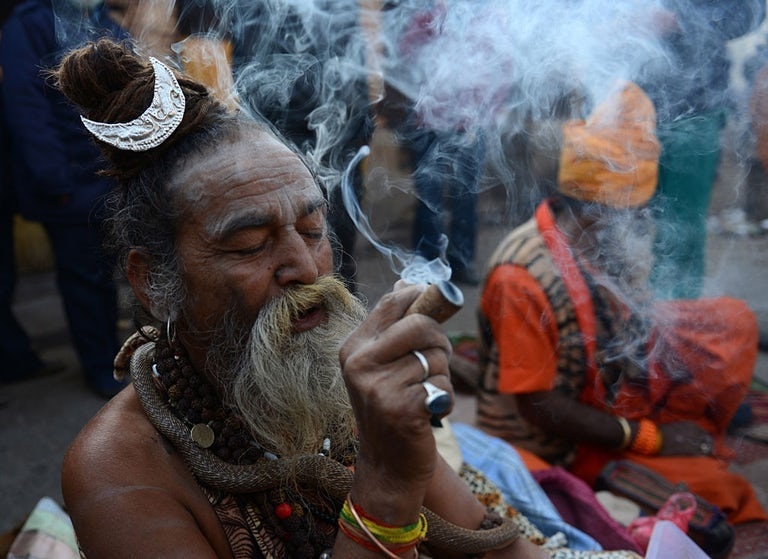Cannabis has a long, intricate relationship with India. According to The Vedas, texts held sacred by Hindus, cannabis is one of nature’s gifts. It’s frequently mentioned as a source of happiness, a reliable way to ease life’s discomfort and bring us joy. Called bhang or ganja in India, depending on whether a product is leaves or female flowers, respectively, cannabis is one of earth’s five essential plants.
Hindu gods are frequently shown interacting with cannabis. Shiva, “the Destroyer,” is sometimes depicted drinking cannabis tea. Researchers believe that Indians have been drinking cannabis concoctions since the beginning of recorded history. [1] Sikh culture frowns on all intoxicants with the exception of cannabis taken in a ritualistic manner. Legend tells the story of Guru Gobind Singh, the founder of the Sikh religion. During a fierce battle against enemies with a raging war elephant, Singh gave one of his followers a strong mixture of bhang and opium, and the follower defeated the elephant.
Interestingly, though, Fleming & Clarke report that “In light of the accepted antiquity of Cannabis in India, it is noteworthy that no Cannabis re-mains have been recovered from archeological [sites] there.” [2]
The Indian Hemp Drugs Commission Report, written by British scholars in the late 19th-century, determined that: “Among the Sikhs, the use of bhang as a beverage appears to be common, and to be associated with their religious practices. The witnesses who refer to this use by the Sikhs appear to regard it as an essential part of their religious rites…” [3]
The Sadhus are another religious group that embraces cannabis. They’re ascetics, living a life of simplicity and physical privation. For Sadhus, cannabis is a way to connect to their deeper spiritual lives. There is even a festival that celebrates Shiva and Sadhu beliefs. Cannabis is enthusiastically consumed by attendees.
Outside of the spiritual or ritualistic use of cannabis in India, medicinal uses are known. One study reports that “In China, the medical use of cannabis never reached the importance it did in India.” [4] It’s thought that the use of cannabis medicinally (and spiritually) likely started near 1000 B.C.E. [5] Cannabis is said to have been used for pain relief (analgesia), as an anti-convulsant, sedative, hypnotic, anti-inflammatory, antibiotic, anti-parasiticidal, appetite stimulant, and aphrodisiac. [5]
A study conducted by William O’Shaughnessy, an Irish physician who was visited India on behalf of the British government, reported his assessment of the medical attributes of cannabis. [6, 7] O’Shaughnessy reported that the intoxicating effects of “hemp” were well-known in India and describes medical uses in treating rheumatism, convulsions, and muscular spasms of tetanus and rabies. [5] O’Shaughnessy’s research helped bring cannabis into Western society.
Cannabis in India is extremely common. Throughout its long history in the country, people who partook were rarely subjugated to the stigma and scrutiny common in the U.S. during the last 100 years. In some parts of India, you might be able to find the plant or “bhang” drinks sold openly by street vendors.
Image source: Herb
References:
- Kuddus, M., I. Ginawi, and A. Al-Hazimi. “Cannabis sativa: An Ancient Wild Edible Plant of India.” Emirates Journal of Food and Agriculture, vol.25, no.10, 2013, pp.736-45. Journal Impact Factor = 0.921, Times Cited = 21 (ResearchGate)
- Fleming, M. and Clarke, R. “Physical Evidence for the Antiquity of Cannabis sativa L.” Journal of the International Hemp Association, Vol. 5, no. 2, 1998, pp. 80-93. [journal impact factor = N/A; cited by 55 (ResearchGate)]
- Oriana Josseau Kalant. “Report of the Indian Hemp Drugs Commission, 1893-94: A Critical Review.” International Journal of the Addictions, vol.7, no.1, 1972, pp.77-96. Journal Impact Factor = 1.132, Times Cited = 35 (Google Scholar)
- Zuardi, A. “History of Cannabis as a Medicine: A Review,” Rev Bras Psiquiatr., Vol. 28 Issue 2, 2006, pp. 153-7. Journal Impact Factor = 0.88, Times Cited = 205 (ResearchGate)
- Mikuriya TH. “Marijuana in Medicine: Past, Present and Future,” Calif Med., Vol. 110, No 1, 1969, pp. 34-40. Journal Impact Factor = N/A, Times Cited = 68 (ResearchGate)
- O’Shaughnessy, W.B. (1838–40). “Case of Tetanus, Cured by a Preparation of Hemp (the Cannabis indica.)”. Transactions of the Medical and Physical Society of Bengal, Volume 8, pp. 462–469. Journal Impact Factor = N/A, Times Cited = 22 (GoogleScholar)
- O’Shaughnessy, W.B. “On the Preparations of the Indian Hemp, or Gunjah,” Transactions of the Medical and Physical Society of Bengal, Vol. 8, 1839, pp. 421-461. Journal Impact Factor = N/A, Times Cited = 312 (GoogleScholar)








